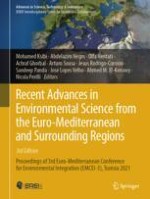2024 | OriginalPaper | Buchkapitel
Comparative Performance of Textile Dye Degradation by Typha domingensis, Phragmites australis and Bolboschoenus glaucus in a Recirculating Horizontal Flow Constructed Wetland
verfasst von : Dalila Haddaji, Zeineb Ghrabi-Gammar, Karim Ben Hamed, Latifa Bousselmi
Erschienen in: Recent Advances in Environmental Science from the Euro-Mediterranean and Surrounding Regions (3rd Edition)
Verlag: Springer Nature Switzerland
Aktivieren Sie unsere intelligente Suche, um passende Fachinhalte oder Patente zu finden.
Wählen Sie Textabschnitte aus um mit Künstlicher Intelligenz passenden Patente zu finden. powered by
Markieren Sie Textabschnitte, um KI-gestützt weitere passende Inhalte zu finden. powered by
